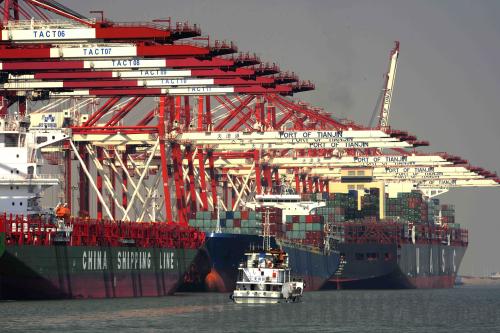|
 |
|
REVITALIZE THE INDUSTRY: A cargo vessel loads at the container berth of Tianjin Port. China drafted revitalization plans for various industries to combat the effects of the global financial crisis (LIU HAIFENG) |
The U.S. economy is recovering, an indication that the source of the 2008 global financial crisis is slowly on the up and the recovery of the world economy is accelerating. Many minds have begun to reflect on the crisis and its ensuing pains in order to understand how various countries coped with the crisis and how they plan to prepare for the next.
Two days are particularly unforgettable in the last five years. First, September 15, 2008, when the 150-year-old Lehman Brothers filed for bankruptcy protection, which experts say unleashed the global economic crisis. Second, November 5, 2008, when China launched its 4-trillion-yuan ($650-billion) stimulus package to cope with the impact of the crisis. China became the first country in the world to issue such a massive measure to combat the crisis and the first major country to recover from it.
During the past five years, the global financial crisis did affect the Chinese economy, but it also had a positive impact: It forced the Chinese economy to develop in a more sound and sustainable way.
The impact of the global financial crisis on the Chinese economy began with exports. China's exports had already been suffering from a harsh winter in the first half of 2008. According to the General Administration of Customs, China's export growth stood at 28.1 percent in May 2008, but had dropped after that. In November 2008, exports declined by 2.2 percent, and the drop in export orders continued until November 2009. China's coastal areas are home to the highest concentration of export-driven companies, but a large number of them were forced to shut down due to declining orders since the latter half of 2008.
At that time foreign trade and investment were the major forces driving up China's economy, therefore the decline of foreign trade adversely impacted the country's economic growth. In the first quarter of 2008 China recorded growth of 11.3 percent, but a year later the growth dropped to 6.6 percent.
In November 2008 the Chinese Government launched the stimulus package and strengthened support to expand exports and consumption. The measures worked. Foreign trade resumed growth in November 2009. In the first quarter of 2010, China saw double-digit growth once more, with the growth rate reaching 12.1 percent. Unlike in Europe and the United States, China only witnessed a brief battering of its economy before its recovery began.
The positive side
After the Chinese economy recovered from the crisis, policymakers began to reflect on the country's economic model, its capability to combat risks and its overall sound development. The conclusion was unsurprising: China cannot continue to rely on a pattern of investment and foreign trade to sustain growth and must shift the gears of growth toward consumption, now a top priority of the Central Government.
To be fair, the Chinese Government realized the need to readjust the country's economic structure back in 2003, but failed to do so out of fears of a decline in economic growth and a rising unemployment rate. In other words, the Chinese economy wasn't yet ready to transform.
But the outburst of the global financial crisis toughened the government's resolve to change course and support new pillars of growth. When the economy started recovering, China issued 10 revitalization plans for a number of industries, including automobile, steel, textile, electronic information and shipbuilding. Moreover, the government granted subsidies for automobile and home appliance purchases to boost consumption. After the new leadership took office in March, government involvement in industrial affairs has been cut back, interest rates have been further liberalized and efforts have been made to encourage more foreign and private investment in sectors once untouchable.
| 